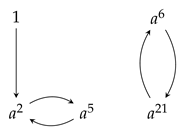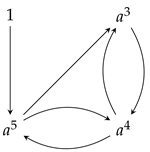Graphical Approach: 2-Complete Decompositions of Groups
Abstract
1. Introduction
- (i)
- , and
- (ii)
- for all with .
2. Main Problems
3. Factor Graph
- (1)
- ;
- (2)
- ;
- (3)
- For each , there exists , such that is an edge.
 |
 |
 |
- (i)
- If the out-degree of 1 is , then .
- (ii)
- If the in-degree of a vertex is , then .
- (i)
- If is a complete decomposition of G with , then is a factor graph.
- (ii)
- If is a factor graph, then is a complete decomposition of G.
- (iii)
- If is a factor graph, then is a complete decomposition of G.
- (i)
- Suppose that is a complete decomposition of G with . By the assumption, we have . It is left to show, that for all , there exists , such that is an edge in . Let . Since , we have for some and . So, and is an edge. Hence, is a factor graph.
- (ii)
- Suppose that is a factor graph. Clearly, . From , we have . Let . If , then . If , then there exists , such that is an edge in . So, for some , i.e., . Hence, and we get . We conclude that is a complete decomposition of G.
- (iii)
- Suppose that is a factor graph. By (ii), it follows that is a complete decomposition of G.
4. Existence of Complete Decompositions
- (i)
- ;
- (ii)
- ;
- (iii)
- ;
- (iv)
- or .
- (i)
- G has a complete decomposition , such that and .
- (ii)
- G has a complete decomposition , such that or .
- (iii)
- G has a 2-complete decomposition.
- (iv)
- and G is not an elementary abelian 2-group.
5. Conclusions and Future Work
- Hypergraphs for higher-order decompositions: The current study focuses on complete decompositions of order two using factor graphs. Extending this framework to hypergraphs could provide insights into complete decompositions with more than two factors, potentially revealing new structural properties of groups through higher-dimensional graphical representations.
- Nonabelian group classes: While our results cover general groups, further investigation into specific classes of nonabelian groups, such as symmetric groups or simple groups, could yield more refined characterizations of complete decompositions and their associated factor graphs.
- Cryptographic applications: The application of complete decompositions in cryptography, as explored in [15,16], suggests potential for developing new cryptographic protocols. Future work could focus on leveraging factor graphs to design secure key exchange protocols or other cryptographic primitives based on the complete decomposition search problem.
- Factor graph properties: The properties of factor graphs, such as connectivity, degree constraints, and cycle structures, warrant further exploration. Investigating these properties could lead to new graph-theoretic tools for classifying groups or understanding the constraints on complete decompositions.
Author Contributions
Funding
Data Availability Statement
Conflicts of Interest
References
- Hajós, G. Covering multidimensional spaces by cube lattices. Mat. Fiz. Lapok 1938, 45, 171–190. [Google Scholar]
- Minkowski, H. Geometrie der Zahlen; Teubner: Leipzig, Germany, 1910. [Google Scholar]
- Hajós, G. Über einfache und mehrfache bedeckung desn-dimensionalen raumes mit einem würfelgitter. Math. Z. 1942, 47, 427–467. [Google Scholar] [CrossRef]
- Itô, N. Über das produkt von zwei abelschen gruppen. Math. Z. 1955, 62, 400–401. [Google Scholar] [CrossRef]
- Amberg, B.; Kazarin, L. Factorizations of groups and related topics. Sci. China Ser. A Math. 2009, 52, 217–230. [Google Scholar] [CrossRef]
- Hajós, G. Sur le problème de factorisation des groupes cycliques. Acta Math. Acad. Sci. Hungar. 1950, 1, 189–195. [Google Scholar] [CrossRef]
- Sands, A. On the factorisation of finite abelian groups. II. Acta Math. Hungar. 1962, 13, 153–169. [Google Scholar] [CrossRef]
- Levy, D.; Maróti, A. Set-direct factorizations of groups. J. Algebra 2018, 516, 414–436. [Google Scholar] [CrossRef]
- Corradi, K.; Hermann, P.Z.; Szabó, S. On factorizations of nonabelian groups. Acta Sci. Math. 2001, 67, 529–533. [Google Scholar]
- Chin, A.Y.M.; Chen, H.V. Complete decompositions of finite abelian groups. Appl. Algebra Eng. Commun. Comput. 2019, 30, 263–274. [Google Scholar] [CrossRef]
- Chin, A.Y.M.; Wang, K.L.; Wong, K.B. Complete decompositions of abelian groups. Commun. Algebra 2021, 49, 2829–2836. [Google Scholar] [CrossRef]
- Chin, A.Y.M.; Wang, K.L.; Wong, K.B. On the size of complete decompositions of finite cyclic groups. Commun. Algebra 2022, 50, 4145–4154. [Google Scholar] [CrossRef]
- Chin, A.Y.M.; Wang, K.L.; Wong, K.B. Complete factorizations of finite abelian groups. J. Algebra 2023, 628, 509–523. [Google Scholar] [CrossRef]
- Sin, C.S.; Chen, H.V.; Wong, D.C. Some constructions of complete decomposition of dihedral group. J. Phys. Conf. Ser. 2019, 1358, 012080. [Google Scholar] [CrossRef]
- Sin, C.S.; Chen, H.V. Group-based key exchange protocol based on complete decomposition search problem. In Information Security Practice and Experience; Lecture Notes in Computer Science; Heng, S.H., Lopez, J., Eds.; Springer: Cham, Switzerland, 2019; Volume 11879, pp. 413–422. [Google Scholar]
- Sin, C.S.; Chen, H.V. Complete decompositions of dihedral groups and group based key exchange protocol. J. Kejuruter. 2021, 33, 733–739. [Google Scholar]
- Cameron, P.J. Graphs defined on groups. Int. J. Group Theory 2022, 11, 53–107. [Google Scholar]
- Ghouchan, M.F.D.; Azimi, A. Factorization graphs of finite groups. Publ. Math. Debrecen 2021, 98, 183–199. [Google Scholar]
- Berkovich, Y.G.; Freiman, G.A.; Praeger, C.E. Small squaring and cubing properties for finite groups. Bull. Aust. Math. Soc. 1991, 44, 429–450. [Google Scholar] [CrossRef]
- Dedekind, R. Ueber gruppen, deren sämmtliche theiler normaltheiler sind. Math. Ann. 1897, 48, 548–561. [Google Scholar] [CrossRef]
- Freiman, G.A. On two- and three-element subsets of groups. Aequ. Math. 1981, 22, 140–152. [Google Scholar] [CrossRef]
Disclaimer/Publisher’s Note: The statements, opinions and data contained in all publications are solely those of the individual author(s) and contributor(s) and not of MDPI and/or the editor(s). MDPI and/or the editor(s) disclaim responsibility for any injury to people or property resulting from any ideas, methods, instructions or products referred to in the content. |
© 2025 by the authors. Licensee MDPI, Basel, Switzerland. This article is an open access article distributed under the terms and conditions of the Creative Commons Attribution (CC BY) license (https://creativecommons.org/licenses/by/4.0/).
Share and Cite
Dong, L.; Wang, K.L.; Wong, K.B. Graphical Approach: 2-Complete Decompositions of Groups. Symmetry 2025, 17, 883. https://doi.org/10.3390/sym17060883
Dong L, Wang KL, Wong KB. Graphical Approach: 2-Complete Decompositions of Groups. Symmetry. 2025; 17(6):883. https://doi.org/10.3390/sym17060883
Chicago/Turabian StyleDong, Lei, Kah Lun Wang, and Kok Bin Wong. 2025. "Graphical Approach: 2-Complete Decompositions of Groups" Symmetry 17, no. 6: 883. https://doi.org/10.3390/sym17060883
APA StyleDong, L., Wang, K. L., & Wong, K. B. (2025). Graphical Approach: 2-Complete Decompositions of Groups. Symmetry, 17(6), 883. https://doi.org/10.3390/sym17060883





